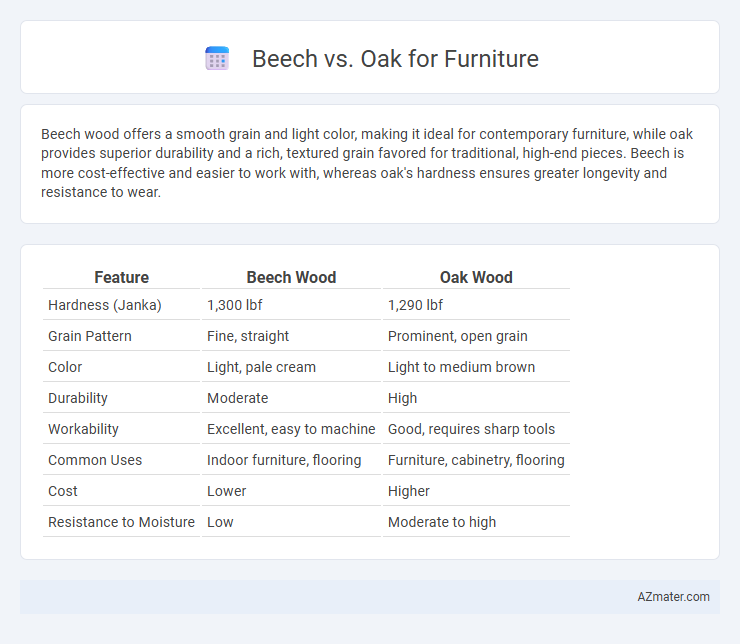Beech wood offers a smooth grain and light color, making it ideal for contemporary furniture, while oak provides superior durability and a rich, textured grain favored for traditional, high-end pieces. Beech is more cost-effective and easier to work with, whereas oak's hardness ensures greater longevity and resistance to wear.
Table of Comparison
| Feature | Beech Wood | Oak Wood |
|---|---|---|
| Hardness (Janka) | 1,300 lbf | 1,290 lbf |
| Grain Pattern | Fine, straight | Prominent, open grain |
| Color | Light, pale cream | Light to medium brown |
| Durability | Moderate | High |
| Workability | Excellent, easy to machine | Good, requires sharp tools |
| Common Uses | Indoor furniture, flooring | Furniture, cabinetry, flooring |
| Cost | Lower | Higher |
| Resistance to Moisture | Low | Moderate to high |
Introduction: Beech vs Oak for Furniture
Beech wood offers a fine grain and smooth texture, making it ideal for crafting detailed furniture pieces with a light, uniform appearance. Oak wood is prized for its durability, prominent grain patterns, and resistance to wear, providing a robust and classic look suited for long-lasting furniture. Comparing beech and oak highlights beech's workability and oak's strength, guiding choices based on aesthetic preference and furniture purpose.
Wood Characteristics: Beech and Oak Compared
Beech wood is fine-grained, smooth, and light-colored, offering excellent workability and a uniform texture ideal for modern furniture designs. Oak features a coarse grain with prominent rays and knots, providing a strong, durable structure favored for classic, sturdy furniture. Both woods have high hardness and wear resistance, but oak's natural moisture resistance makes it more suitable for outdoor or heavy-use pieces.
Durability and Strength Differences
Beech and oak are both popular hardwoods used in furniture making, with oak generally offering superior durability due to its denser, tighter grain structure. Oak's high Janka hardness rating, typically around 1,200, makes it more resistant to dents and scratches compared to beech, which has a Janka rating near 1,300 but softer in practical use due to its finer grain. While beech provides excellent strength and shock resistance for furniture, oak's naturally higher resistance to wear and moisture enhances its long-term performance in heavy-use applications.
Aesthetic Appeal: Color and Grain Patterns
Beech furniture showcases a light creamy color with a subtle, tight grain pattern that offers a smooth and uniform aesthetic, ideal for contemporary and minimalist decor. Oak furniture features a richer, golden to medium brown hue with pronounced grain patterns and natural knots, imparting a rustic and traditional charm. Choosing between beech and oak depends on whether a sleek, modern look or a warm, textured appearance best complements the interior design style.
Workability for Furniture Making
Beech wood offers excellent workability due to its fine grain and consistent texture, making it easy to machine, shape, and finish for detailed furniture designs. Oak, while harder and denser, provides high durability but can be more challenging to work with, requiring sharper tools and more effort when cutting and sanding. Both woods respond well to stains and finishes, but beech allows for smoother edges and intricate joinery, making it a preferred choice for complex furniture pieces.
Cost and Availability
Beech wood is generally more affordable and widely available compared to oak, making it a popular choice for budget-conscious furniture buyers. Oak, known for its durability and distinctive grain patterns, tends to be more expensive due to slower growth rates and higher demand in premium furniture markets. Availability of beech wood is higher in European regions, while oak is sourced globally but can fluctuate in price depending on quality and origin.
Maintenance and Longevity
Beech furniture requires regular maintenance such as frequent polishing to prevent drying and cracking, while oak is naturally more resistant to wear and moisture, needing less frequent upkeep. Oak's dense grain structure offers superior durability and longevity, often lasting generations with minimal care compared to beech. Both woods benefit from protective finishes, but oak's inherent strength makes it a preferred choice for long-lasting furniture requiring less intensive maintenance.
Environmental Impact and Sustainability
Beech and oak differ significantly in environmental impact and sustainability, with beech known for faster growth rates and higher yield per hectare, making it a more renewable choice for furniture production. Oak, while prized for its durability and aesthetic appeal, often grows more slowly and thus requires longer rotation periods, which can increase its ecological footprint. Sustainable forestry practices such as certified harvesting and responsible sourcing are essential for both woods to minimize deforestation and support biodiversity conservation.
Best Uses: Ideal Furniture Types for Each Wood
Beech wood, known for its fine grain and hardness, is ideal for making chairs, tables, and cabinetry that require durability and smooth finishes. Oak excels in crafting robust furniture such as dining tables, flooring, and outdoor pieces due to its natural strength and resistance to wear. The suitability of each wood depends on the desired aesthetic and functional qualities, with beech favored for modern, sleek designs and oak preferred for traditional, heavy-use furniture.
Conclusion: Choosing Between Beech and Oak
Beech furniture offers a smooth texture and light color ideal for modern, minimalist designs, while oak provides exceptional durability and a prominent grain pattern suitable for rustic or traditional styles. Oak generally resists wear and moisture better, making it preferable for high-traffic or humid environments, whereas beech is easier to machine and more cost-effective. Selecting between beech and oak depends on desired aesthetics, usage conditions, and budget considerations.

Infographic: Beech vs Oak for Furniture
 azmater.com
azmater.com